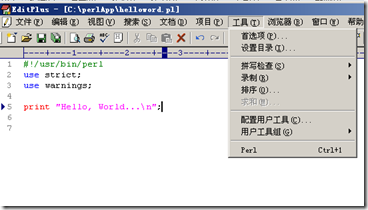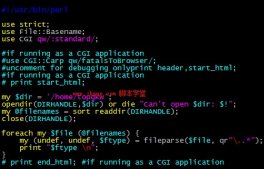What do the ->, => and :: symbols mean?
The -> is the "infix dereference operator". In other words it is the means by which one calls a sub with a pass by reference (among other things you can do with ->). As stated above most things in calls to perl/Tk routines are passed by reference. The -> is used in perl just as in C or C++. (Most of the widget primitives are elements of the Tk:: "perl class".) A simple example of dereferencing would be: $x = { def => bar }; # $x is a reference to an anon. hash print $x->{def},"/n"; # prints ``bar''
Note that in the case of calling perl/Tk subs there may be more than one way to call by reference. Compare my($top) = MainWindow->new;
with my($top) = new MainWindow;
But in general you will be making extensive use of calls like: $top -> Widge-type;
There is a clear and succint discussion of references, dereferences, and even closures in man perlref(1) or see the perl 5 info page at: http://www.metronet.com/perlinfo/perl5.html
The use of the => operator is quite common in perl/Tk scripts. Quoting from man perlop(1):
The => digraph is simply a synonym for the comma operator. It's useful for documenting arguments that come in pairs.
You could say that => is used for aesthetic or organizational reasons. Note in the following how hard it is to keep track of whether or not every -option has an argument: $query -> Button(-in,/$reply,-side,'left',-padx,2m,-pady, 2m,-ipadx,2m,-ipady,1m)->pack(-side,'bottom');
As opposed to: $query ->Button( -in => /$reply, -side => 'left', -padx => 2m, -pady => 2m, -ipadx => 2m, -ipady => 1m )->pack(-side => 'bottom');
By the way if you wanted the numeric "greater than or equal" you would use >= not =>.
While the :: symbol can be thought of as similar to the period in a C struct, it is much more akin to the :: class scope operator in C++: a.b.c; /* something in C */ a::b::c(); // function in C++ $a::b::c; # a scalar in Perl 5 @a::b::c; # a list in Perl 5 %a::b::c; # an associative array or "hash" in Perl 5 &a::b::c; # a function in Perl 5
It is also analogous to the single forward quotation mark in perl 4: $main'foo; # a $foo scalar in perl 4 $main::foo; # a $foo scalar in Perl 5
For backward compatibility perl 5 allows you to refer to $main'foo but $main::foo is recommended.
譯文:
符號->,=>和::分別表示什么意思?
‘- >'符號是“插入式解引用操作符”(infix dereference operator)。換句話說,它是調用由引用傳遞參數的子程序的方法(當然,還有其它的作用)。正如我們上面所提到的,在調用Perl/Tk的函數的時候,大部分參數都是通過引用傳遞的。Perl中的‘->'功能就和它們在C或C++中一樣。(大部分原始的組件都是Tk中的Perl類的元素。)下面是一個簡單的解引用的例子:
$x = { def => bar }; # $x是指向一個匿名hash的引用
print $x->{def},"/n"; # 輸出``bar''
注意,在調用Perl/Tk的子程序時有多種不同的方法進行引用。我們可以比較一下:
my($top) = MainWindow->new;
和
my($top) = new MainWindow;
兩種方法的不同。
但是,一般來說我們通常都使用這樣的方法調用:
$top -> Widge-type;
在perlref的手冊頁中有詳盡的關于引用、解引用、和閉包的討論,或者也可以在下面的網頁上查看Perl5的信息頁:
http://www.metronet.com/perlinfo/perl5.html
在Perl/Tk的腳本中‘=>'操作符時很常見的。perlop手冊頁中說:關系操作符=>只是逗號操作符的替代物,它在顯示成對的參數時非常有用。
你可以認為=>只是為了程序的美觀和易維護而被使用的。請看,在下面的例子中,要想監測是否每個選項都有對應的值,是多么的困難:
$query -> Button(-in,/$reply,-side,'left',-padx,2m,-pady,
2m,-ipadx,2m,-ipady,1m)->pack(-side,'bottom');
而下面的這個則相反:
$query ->Button( -in => /$reply,
-side => 'left',
-padx => 2m,
-pady => 2m,
-ipadx => 2m,
-ipady => 1m
)->pack(-side => 'bottom');
順便說一下,如果你需要用數字“大于等于”的符號,你應該用“>=”而不是“=>”。
“::”符號可以認為是與C語言中的“.”相似的,而它更像C++中的::類范圍操作符。
a.b.c; /* C語言中的 */
a::b::c(); // C++ 中的函數
$a::b::c; # Perl 5中的標量
@a::b::c; # Perl 5中的列表
%a::b::c; # Perl 5中的關聯數組(或叫hash)
&a::b::c; # Perl 5中的函數
另外,Perl4中的單撇號也具有相同的功能:
$main'foo; # Perl 4中的標量$foo
$main::foo; # Perl 5中的標量$foo
出于向后兼容的考慮,Perl5也運行使用$main'foo,但是仍推薦使用$main::foo。




